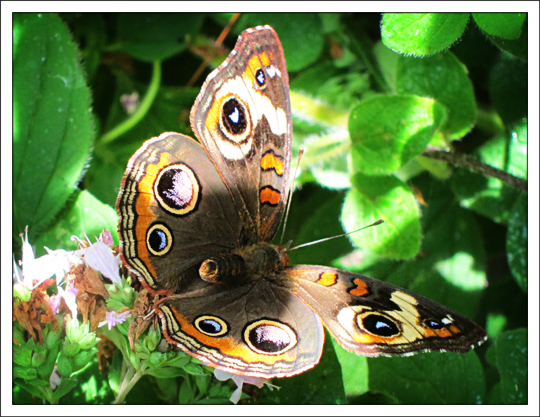Butterflies of the Adirondack Mountains:
Common Buckeye (Junonia coenia)
 Butterflies of the Adirondacks: Common Buckeye in the Paul Smiths VIC Butterfly House (25 August 2012)
Butterflies of the Adirondacks: Common Buckeye in the Paul Smiths VIC Butterfly House (25 August 2012)
| This page is no longer being updated. For an updated version of this material, see: Common Buckeye (Junonia coenia). |
The Common Buckeye (Junonia coenia) is a medium-sized, brown butterfly with large eyespots which was seen in the Adirondack Mountains in upstate New York in late summer 2012. It is a member of the Brushfoot family, named for the large colorful eyespots on the upper side of the wings. The eye spots may be used to scare away predators. [1] The genus name (coenia) may be derived from June, the wife of Jupiter. [2] Buckeyes are primarily a tropical group and cannot survive freezing temperatures. [3] Buckeyes reportedly fly with a series of quick wing beats followed by glides. [4]
From above, the Common Buckeye has two orange bars on the fore wing on a field of dark brown, as well as an orange submarginal band on the hind wing and two bright eyespots on each wing. On the fore wing, there is one very small eyespot near the tip and one large eyespot in the white fore wing bar. On the hind wing, there is one large eyespot near the upper margin and one small eye spot below it. The eye spots are black with a rim of yellow and iridescent blue and lilac irises. From below, the eyespots are tiny or absent. [5] The wingspan of the Common Buckeye is about two inches. [6] Females are larger than males. [7]
 Butterflies of the Adirondacks: Common Buckeye in the Paul Smiths VIC Butterfly House (25 August 2012)
Butterflies of the Adirondacks: Common Buckeye in the Paul Smiths VIC Butterfly House (25 August 2012)
Female Common Buckeyes lay eggs singly on leaf buds or on the upper side of host plant leaves. [8] The eggs of the Common Buckeye are dark green. The caterpillar reportedly is highly variable in color, [9] mostly dark or greenish to blackish-gray with orange and yellowish markings. Host plants include snapdragon, toadflax, and plantains. [10] Adults feed on nectar. [11] Nectar sources reportedly include species such as chickory, knapweed, tickseed sunflower, aster, peppermint, and dogbane. [12] [13] [14]
The Common Buckeye can be found in cities, suburbs, towns, shorelines, roadsides, fields and meadows, and other open places.[15] [16] [17] This butterfly is said to be especially fond of sandy areas and paths where it can be seen resting on the he ground. [18] Common Buckeyes are most common in the southern regions of the US. [19] In the summer, adults reportedly move northward, sometimes reaching southern Canada. [20] [21] [22] [23] The Common Buckeye does not overwinter in the north, but moves southward in September and October. [24] [25] The seasonal movements of this butterfly are said to track coastlines and river corridors. [26]
Prior to 2012, we had not had Common Buckeyes in the Paul Smiths VIC Native Species Butterfly House. However, in July and August 2012, Buckeyes were present in the Butterfly House and the surrounding area. This may be the first occurrence in our part of the Adirondack Mountains. [27]
References
- Susan Grimm Hanley. Interpretive Naturalist, Paul Smith's College Native Species Butterfly House. Species Logbooks.
- Butterflies and Moths of North American. Species Profiles. Sighting records: 8/25/12; 8/25/12
- Government of Canada. Canadian Biodiversity Information Facility. SpeciesBank.
- Massachusetts Butterfly Club. Massachusetts Butterfly Species List.
- ENature. Field Guides.
- Iowa State University. Department of Entomology. BugGuide.
- National Audubon Society. Field Guide to Butterflies (New York: Alfred A. Knopf, 1981), pp. 630-632.
- Jim P. Brock and Kenn Kaufman. Kaufman Field Guide to Butterflies of North America (Houghton Mifflin, 2003), pp. 206-207.
- Paul A. Opler. A Field Guide to Eastern Butterflies (The Peterson Field Guide Series, Houghton Mifflin Company, 1992,1998), pp. 88-89, 273-274.
- Jeffrey Glassberg. Butterflies of North America (Michael Friedman Publishing, 2002), pp. 152-153.
- James A. Scott. The Butterflies of North America. A Natural History and Field Guide (Stanford University Press, 1986), p. 276-277.
- Donald and Lillian Stokes. Stokes Butterfly Book. The Complete Guide to Butterfly Gardening, Identification, and Behavior (Little, Brown and Company, 1991), pp. 72-75.
- Jeffrey Glassberg. Butterflies through Binoculars. The East. A Field Guide to the Butterflies of Eastern North America (Oxford University Press, 1999), p. 124-125, Plate 37.
- Paul A. Opler and George O. Krizek. Butterflies East of the Great Plains: An Illustrated Natural History (The Johns Hopkins University Press, 1984), pp. 162-163, Plate 30.
- Rick Cech and Guy Tudor. Butterflies of the East Coast. An Observer's Guide (Princeton University Press, 2005), p. 192.
- Ken Preston-Mafham. Identifying Butterflies. The new compact study guide and identifier (Chartwell Books, 1999), p. 41.
